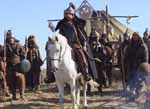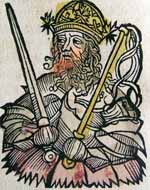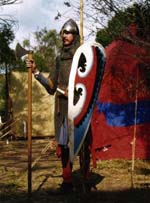The Medieval World
Medieval World Information
News
- coming soon
Links
Site Info
Welcome, Guest
The Major Barbarian Invasions of the Early Medieval Period
For the purposes of this article we will look at two major sources of population movement, and invasions, during the early centuries of the Medieval period - the Huns and the Germanic Tribes.
The Huns
The Huns were a nomadic people from the steppes of Mongolia, Central Asia. They lived by herding cattle and developed skills with horses and archery that were unequalled elsewhere in the world. For over a thousand years, they had invaded the territory of settled populations over thousands of miles away, looking for fresh pastures and booty and these incursions would continue until the thirteenth century (Genghis Khan and the Golden Horde)
In the 4th and 5th centuries, they attacked China, India, Persia and Europe. There seemed no way for settled populations to resist these invasions, given the superior mobility, horsemanship and archery skills of the Huns. In the 4th century AD, they began to make rapid and devastating incursions into urban Europe, riding across the vast plains of present-day Hungary. Attila led the attacks on Europe, in the 5th century, invading Gaul and Italy. Attila died in AD 453 and the Hun attacks disintegrated. However, the impact of their attacks remained, culminating in the fall of the Western Roman Empire.
Germanic tribes
As the Huns progressed through Europe, they had driven various Germanic tribes from their land. These tribes, characterised by the Romans as "barbarians", were mainly made up of settled farmers. They came from lands north of the Roman frontiers:- the Franks and Saxons, were from the north of the Rhine; and Ostrogoths from the land to the north of the Danube. The Ostrogoths, driven from their Ukrainian territory by the Huns, drove out the Visgoths, who then pushed the Alan, Suebi and Vandals towards the west and south of the Empire.
By the end of the 5th century, Germanic kingdoms had replaced the Roman provinces:- Angles and Saxons in England; Franks in France; Ostrogoths in Italy; Visgoths in Spain and Vandals in Roman Africa. These kingdoms were usually Christian and were generally based in rural areas rather than the remnants of the Roman towns and cities. In Britain for example, the towns were almost deserted until the eighth century. Anglo-Saxon chiefs lived in the countryside in wooden warrior halls, with the rest of their tribe housed in wooden or mud huts. The abandonment of stone as a building material means that there is very little remaining archaeological evidence of Anglo-Saxon homes.




